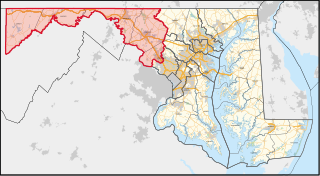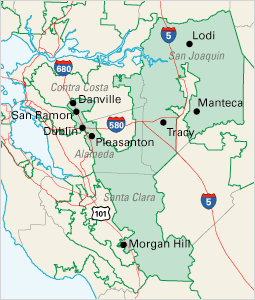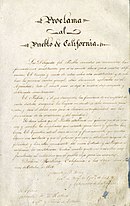The government of the U.S. state of Missouri is organized into the state government and local government, including county government, and city and municipal government.

For about a hundred years, from after Reconstruction until the 1990s, the Democratic Party dominated Texas politics, making part of the Solid South. In a reversal of alignments, since the late 1960s, the Republican Party has grown more prominent. By the 1990s, it became the state's dominant political party and remains so to this day, as Democrats have not won a statewide race since the 1994 Lieutenant gubernatorial election.

Maryland's 6th congressional district elects a representative to the United States House of Representatives from the northwest part of the state. The district comprises all of Garrett, Allegany, Frederick, and Washington counties as well as a portion of Montgomery County. David Trone (D) is its current representative.
New Jersey is one of the fifty U.S. states. The state is considered a stronghold of the Democratic Party and has supported the Democratic candidate in every presidential election since 1992. Democrats have also controlled both chambers of the state legislature since 2004. New Jersey currently has two Democratic United States senators. New Jersey's Class I Senate seat has been Democratic since 1959. New Jersey's Class II Senate seat has been Democratic since 1979. In addition, New Jersey's House congressional delegation has had a Democratic majority since 1965, except for a period between 1995-1999 and 2013-2017. As of July 1, 2020, there were more registered Democrats than unaffiliated voters for the first time in history, as there are more Democrats than Republicans as well.

The politics of Louisiana involve political parties, laws and the state constitution, and the many other groups that influence the governance of the state. The state was a one-party Deep South state dominated by the Democratic Party from the end of Reconstruction to the 1960s, forming the backbone of the "Solid South." This was due to the near-total disenfranchisement of the state's large African-American population during this time, who mostly voted Republican. The Civil Rights era turned the state into a competitive one on the federal level, as it voted for the nationwide winner in every election between 1972 and 2004. It remained Democratic on the state and local level until the turn of the 21st century, allowing Republicans to win control of the state legislature and every statewide office in 2011. Republicans won a United States Senate seat for Louisiana in the election of 2004, for the first time since 1876. Republicans captured both seats in the election of 2014 for the first time since 1872. In the election of 2008, the state voted for a losing presidential candidate for the first time since 1968. Democrats won less than 40% of the presidential popular vote in the state in the elections of 2016 and 2020.
Political control of Ohio has oscillated between the two major parties. Republicans outnumber Democrats in Ohio government. The governor, Mike DeWine, is a Republican, as are all other non-judicial statewide elected officials: Lieutenant Governor of Ohio Jon A. Husted, Ohio Attorney General Dave Yost, Ohio State Auditor Keith Faber, Ohio Secretary of State Frank LaRose and Ohio State Treasurer Robert Sprague.

The politics of Oklahoma exists in a framework of a presidential republic modeled after the United States. The governor of Oklahoma is both head of state and head of government, and of a pluriform two-party system. Executive power is exercised by the governor and the government. Legislative power is vested in the governor and the bicameral Oklahoma Legislature. Judicial power is vested in the judiciary of Oklahoma. The political system is laid out in the 1907 Oklahoma Constitution.

Minnesota is known for a politically active citizenry, with populism being a longstanding force among the state's political parties. Minnesota has consistently high voter turnout; in the 2008 U.S. presidential election, 77.8% of eligible Minnesotans voted – the highest percentage of any U.S. state or territory – versus the national average of 61.7%. This was due in part to its same day voter registration laws; previously unregistered voters can register on election day, at their polls, with evidence of residency.
Like many other U.S. states, the politics of Oregon largely concerns regional issues. Oregon leans Democratic as a state, with both U.S. senators from the Democratic party, as well as four out of Oregon's six U.S. Representatives. The Democratic candidate for president has won in Oregon in every election since 1988. Both houses of Oregon's legislative assembly have been under Democratic control since the 2012 elections.

Pennsylvania has been considered a swing state throughout its entire history as it only voted for the nationwide loser on only 10 occasions, meaning it has voted for the national winner 83% of the time as of 2020. Although, it generally supported Republicans between the Civil War and New Deal eras, as it voted Republican in every election between 1860 and 1932, except for 1912, when the Republican vote was split. Even then, the state's strong Republican ties meant that it backed Republican-turned-Progressive Theodore Roosevelt. The state backed a Democrat in 1936 for the first time since 1856. Pennsylvania generally leaned Democratic since the 1990s, as it backed the Democratic presidential candidate in every election since 1992 except in 2016, when it was won by Republican candidate Donald Trump with a plurality.
The US state of Illinois is a Democratic stronghold and one of the "big three" Democratic states alongside California and New York. It is considered one of the most Democratic states in the nation and following the 2018 elections, all six statewide elected offices are held by a Democrat. However, there is a sharp division between Democratic cities, college towns, and population centers, and highly conservative rural regions, which continue to be dominated by Republicans, but are drowned out due to their relatively low population.
The politics of Colorado, United States, are that of a blue state. Once considered a swing state that used to be Republican-leaning, Colorado has been trending Democratic since the early part of the 21st century due to changing demographics and a rising number of the large unaffiliated bloc of voters leaning Democratic. The growing shift of the state's Republican Party towards social and religious conservatism along with shifting further to the right has also been cited as reasons for the changing voting patterns of Colorado.
Indiana has long been considered to be a Republican stronghold and is rated R+11 on the Cook Partisan Voting Index. The current governor of Indiana is Republican Eric Holcomb, and Republicans hold supermajorities in both chambers of the Indiana General Assembly. It has only supported a Democrat for president four times since 1912—in the elections of 1932, 1936, 1964, and 2008. Historically, the state was a swing state, voting for the national winner all but four times from 1816 to 1912, with the exceptions of 1824, 1836, 1848, and 1876.

The Government of Mississippi is the government of the U.S. state of Mississippi. Power in Mississippi's government is distributed by the state's Constitution between the executive and legislative branches. The state's current governor is Tate Reeves. The Mississippi Legislature consists of the House of Representatives and Senate. Mississippi is one of only five states that elects its state officials in odd numbered years. Mississippi holds elections for these offices every four years in the years preceding Presidential election years. Thus, the last year when Mississippi elected a Governor was 2019, and the next gubernatorial election will occur in 2023.
The Commonwealth of Massachusetts is often categorized politically as progressive and liberal. All of the state’s U.S. representatives and senators are Democrats. Democrats also form the large majority of the state’s legislature, though the state has a history of electing Republican governors. As with most states, the two main political parties are the Democratic Party and the Republican Party.
The politics of Michigan, a competitive state that leans Democratic in presidential elections, are divided. Michigan is considered part of the Democrats' "Blue Wall." Governors since the 1970s have alternated between the two parties, and statewide offices including attorney general, secretary of state, and senator have been held by members of both parties in varying proportions, though the state currently is represented by two Democratic U.S. Senators and Democrats hold every statewide office. The Democratic Party has a slim majority of two seats in the Senate of the Michigan Legislature, and the House is currently deadlocked at 54 seats for each party. The state's congressional delegation is commonly split, with one party or the other typically holding a narrow majority, and Democrats currently have a 7-6 majority.

Like most U.S. states, North Carolina is politically dominated by the Democratic and Republican political parties. North Carolina has 14 seats in the U.S. House of Representatives and two seats in the U.S. Senate. North Carolina has voted for the Republican candidate in all but one presidential election since 1980; the one exception was in 2008, when a plurality of North Carolinians voted for Barack Obama. However, since that election, the state has remained closely contested with Republicans winning by no more than four points and obtaining a majority of the vote only in 2012. This stands in contrast to the post-Civil War era, as the state was a strongly Democratic Solid South state from 1880 to 1964, only voting Republican in 1928.

The politics of Georgia change frequently and often follow the rest of the United States in major historical landmarks. The state has a long history, starting in the 18th century as a British colony. The cultural makeup of the early colony led to a ban on slavery being overturned soon after its implementation, setting the stage for the many plantations in the state. Rival governments were formed during the Revolutionary War, with the Patriot government surviving and forming a unified state government after the war. Georgian politics then followed the Democratic-Republican Party before the American Civil War and the Democrats afterward. In fact, the state never voted Republican until 1964, making it the last continental state to do so. Since then, Democrats have won the state just four times, for native son Jimmy Carter in 1976 and 1980, Southerner Bill Clinton in 1992, and for Joe Biden in 2020.

The U.S. state of Arizona, in common with the other U.S. states, must redraw its congressional and legislative districts every ten years to reflect changes in the state and national populations. Redistricting normally follows the completion of the United States census, which is carried out by the federal government the first year of every decade; the most recent census took place in 2020. Historically, Arizona's legislature had control over the redistricting process. However, Proposition 106, passed in 2000, delegated the power to draw congressional and legislative boundaries to a bipartisan independent commission. The Arizona Independent Redistricting Commission (AIRC) comprises two Democrats, two Republicans, and one independent chair. County and local redistricting, which normally takes place along the same timeline as congressional and legislative redistricting, is carried out by the individual county and local governments rather than the AIRC.

Redistricting in California has historically been highly controversial. Critics have accused legislators of attempting to protect themselves from competition by gerrymandering districts. Conflicts between the governor and the legislature during redistricting often have only been resolved by the courts.














